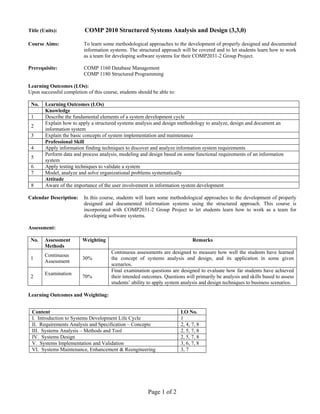
Algoritmos comp2010
- 1. Page 1 of 2 Title (Units): COMP 2010 Structured Systems Analysis and Design (3,3,0) Course Aims: To learn some methodological approaches to the development of properly designed and documented information systems. The structured approach will be covered and to let students learn how to work as a team for developing software systems for their COMP2031-2 Group Project. Prerequisite: COMP 1160 Database Management COMP 1180 Structured Programming Learning Outcomes (LOs): Upon successful completion of this course, students should be able to: No. Learning Outcomes (LOs) Knowledge 1 Describe the fundamental elements of a system development cycle 2 Explain how to apply a structured systems analysis and design methodology to analyze, design and document an information system 3 Explain the basic concepts of system implementation and maintenance Professional Skill 4 Apply information finding techniques to discover and analyze information system requirements 5 Perform data and process analysis, modeling and design based on some functional requirements of an information system 6 Apply testing techniques to validate a system 7 Model, analyze and solve organizational problems systematically Attitude 8 Aware of the importance of the user involvement in information system development Calendar Description: In this course, students will learn some methodological approaches to the development of properly designed and documented information systems using the structured approach. This course is incorporated with COMP2031-2 Group Project to let students learn how to work as a team for developing software systems. Assessment: No. Assessment Methods Weighting Remarks 1 Continuous Assessment 30% Continuous assessments are designed to measure how well the students have learned the concept of systems analysis and design, and its application in some given scenarios. 2 Examination 70% Final examination questions are designed to evaluate how far students have achieved their intended outcomes. Questions will primarily be analysis and skills based to assess students’ ability to apply system analysis and design techniques to business scenarios. Learning Outcomes and Weighting: Content LO No. I. Introduction to Systems Development Life Cycle 1 II. Requirements Analysis and Specification – Concepts 2, 4, 7, 8 III. Systems Analysis – Methods and Tool 2, 5, 7, 8 IV. Systems Design 2, 5, 7, 8 V. Systems Implementation and Validation 3, 6, 7, 8 VI. Systems Maintenance, Enhancement & Reengineering 3, 7
- 2. Page 2 of 2 References: L. D. Bentley and J. L. Whitten, System Analysis and Design for the Global Enterprise (7th Edition), McGraw-Hill, 2007. A. Dennis, B.H. Wixom and R. M. Roth, Systems Analysis and Design, (3rd Edition), Wiley, 2006. J.A. Hoffer, J.P. Geroge and J.S. Valacich, Modern Systems Analysis and Design (5th Edition), Pearson/Prentice Hall, 2008. K. E. Kendall and J. E. Kendall, Systems Analysis And Design, Pearson/Prentice Hall, (7th Edition), 2008. R.S. Pressman, Software Engineering: A Practitioners Approach (6th edition), New York: McGraw Hill, 2004. I. Sommerville, Software Engineering (8th edition), Wokingham: Addison-Wesley, 2007. E. Yourdon, Modern Structured Analysis, Prentice Hall, 1989. Course Content in Outline: Topic I. Introduction to Systems Development Life Cycle II. Requirements Analysis and Specification – Concepts III. Systems Analysis – Methods and Tool A. Data flow diagrams B. Entity relationship diagrams C. Process specifications D. State transition diagrams IV. Systems Design A. Modular design concepts B. Application architectural and modeling C. Database design D. Input and output design E. User interface design V. Systems Implementation and Validation A. Systems Construction and Implementation B. Testing techniques and strategies VI. Systems Maintenance, Enhancement & Reengineering